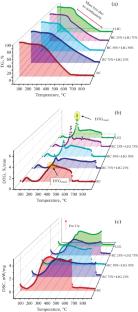Thermal Analysis of Lignite, Lignin, and Their Mixtures in an Oxidizing Atmosphere
Abstract
The utilization of industrial biomass waste is a priority today. A promising approach is the combustion of biomass with traditional fuels. In the present work, the combustion of lignite and lignin is investigated, with slow heating. Mixtures containing 25, 50, and 75 wt % lignin are considered; the particle size is 100–200 μm. The lignite and lignin are subjected to technical and elemental analysis. Thermal analysis is employed in experiments with heating at 10°C/min an oxidative medium (air flow rate 50 mL/min). By thermal analysis, the heating process may be divided into three stages: removal of moisture and sorbed and occluded materials; thermal decomposition, with the emission and combustion of volatiles; and ignition and combustion of the carbon residue. The basic combustion parameters for the carbon residue are determined from the results of thermal analysis: the ignition and combustion temperatures; the maximum rate of mass loss and the corresponding temperature; and the combustion index. It is established that the ignition temperature of the carbon residue is 15% lower for lignin than for lignite. Therefore adding 25% lignin to lignite lowers the ignition point by 12%. The interaction of the fuel components that synergetically affect the combustion intensity is also analyzed. The results may be used in converting coal-fired boilers for the combustion of lignite–biomass mixtures.


 求助内容:
求助内容: 应助结果提醒方式:
应助结果提醒方式:


